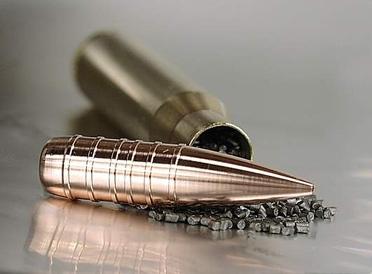

 The Accurate Reloading Forums
The Accurate Reloading Forums  THE ACCURATE RELOADING.COM FORUMS
THE ACCURATE RELOADING.COM FORUMS  Guns, Politics, Gunsmithing & Reloading
Guns, Politics, Gunsmithing & Reloading  Bullet Making
Bullet Making  Can a Driven Multi-Roller Be Used In Place Of A Swaging Press
Can a Driven Multi-Roller Be Used In Place Of A Swaging PressGo  | New  | Find  | Notify  | Tools  | Reply  |  |
| One of Us |
A shop where I worked used multi-roller units to reduce the size of round rod. The rollers were set parallel with a hollow where the rod to be sized was placed. The rollers were then driven and one roller that was on a pivot was slowly advanced in and by doing so, compressed the rod. The amount of advance determined final diameter of the rod. The rollers were hardened and the rod that was resized was of a soft steel or other soft metal. Does this method have any potential when considering swaging 35 cal. bullets down by around 0.010 to 0.348. Bob N. Bob Nisbet DRSS & 348 Lever Winchester Lover Temporarily Displaced Texan If there's no food on your plate when dinner is done, you didn't get enough to eat. | ||
|
| One of Us |
Bob, I can see two potential problems with rolling lead core bullets to reduce their diameter; first the lead core would want to move forward and deform the nose profile, second the jacket spring back would probably leave the core a rather loose fit in the jacket causing accuracy problems. I don't have any idea what solid type bullet would do if it were treated to a run through the rollers. Just my thoughts. | |||
|
One of Us |
I considered building a bullet making machine using that principle. It was going to have rollers that cut the lead as they 'sueezed' down. I might still build it one day. To answer the question, if the bullets were heated befor rolling, the jackets might contract sufficiently on cooling to hold the core tight. Just a thought. Regards 303Guy | |||
|
| One of Us |
I was not thinking about lead core bullets. My idea had solid copper type bullets as the intended material. Example Barnes X bullets. Since Barnes discuntinued their .348 X solid copper bullets, these may be considered a viable test case item. Thought is to take a Barnes X in .358 caliber and reduce to .348. If a .358 can be accurately/efficiently "rolled" down by 0.010, then the method could be useful where the .348 and other obsolete bullets are still in demand. Bob Nisbet DRSS & 348 Lever Winchester Lover Temporarily Displaced Texan If there's no food on your plate when dinner is done, you didn't get enough to eat. | |||
|
| One of Us |
I'm just guessing but I think the short bearing surface and bullet shape might cause a bit of a problem keeping the bullet parallel...but the only way to know is to try it and see...it's also like using a double jack to kill a flea. You can have just about ANY CNC shop turn you out all the bullets you could possibly want or go to some of the brass bullet makers on the net and get ANY size bullet for <2 bucks each. You have a good idea but there are a lot easier ways to get what you want...especially for obtaining obsolete bullets. I'm sure Macifej at S&H Super Precision, or Rob could turn you out all you want. Luck | |||
|
| One of Us |
Bob This is a real bad idea. Whenever you "move" copper, you harden it. Rolling, along with drawing, are the two methods that are used to harden copper rod and wire. If you were able to use this machinery, a mono bullet would come out WAAAAY harder than the bullet that went in with all the unknowns as to pressures generated. At the very least, it would probably return the copper bullet to HO4 condition if, in fact, it didn't move it into the spring hard condition. | |||
|
| Powered by Social Strata |
| Please Wait. Your request is being processed... |
|
 The Accurate Reloading Forums
The Accurate Reloading Forums  THE ACCURATE RELOADING.COM FORUMS
THE ACCURATE RELOADING.COM FORUMS  Guns, Politics, Gunsmithing & Reloading
Guns, Politics, Gunsmithing & Reloading  Bullet Making
Bullet Making  Can a Driven Multi-Roller Be Used In Place Of A Swaging Press
Can a Driven Multi-Roller Be Used In Place Of A Swaging Press

Visit our on-line store for AR Memorabilia

